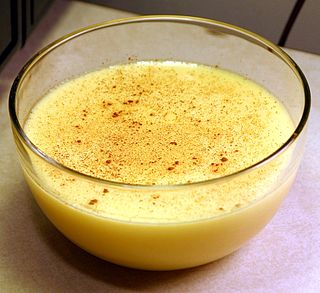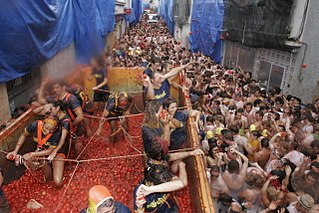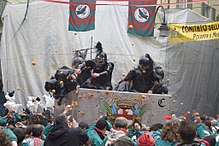
Dessert is a course that concludes a meal. The course consists of sweet foods, such as cake, biscuit, ice cream and possibly a beverage such as dessert wine and liqueur. Some cultures sweeten foods that are more commonly savory to create desserts. In some parts of the world there is no tradition of a dessert course to conclude a meal.

Custard is a variety of culinary preparations based on sweetened milk, cheese, or cream cooked with egg or egg yolk to thicken it, and sometimes also flour, corn starch, or gelatin. Depending on the recipe, custard may vary in consistency from a thin pouring sauce to the thick pastry cream used to fill éclairs. The most common custards are used in custard desserts or dessert sauces and typically include sugar and vanilla; however, savory custards are also found, e.g., in quiche.

La Tomatina is a Spanish festival in Buñol, Spain where participants throw tomatoes at each other. It is said to be the biggest food fight in the world. From the festivals origin as a food fight between friends in the 1940's, it has become a famous tourist attraction. Previous to 2013, the festival did not operate with an upper cap on the number of attendees which would cause a strain on Buñol's population of about 9.000 inhabitants. Since 2013, however, the festival has a ticketed event with a capacity of 20.000 participants.

An apple pie is a fruit pie in which the principal filling is apples. Apple pie is often served with whipped cream, ice cream, custard or cheddar cheese. It is generally double-crusted, with pastry both above and below the filling; the upper crust may be solid or latticed. The bottom crust may be baked separately ("blind") to prevent it from getting soggy. Deep-dish apple pie often has a top crust only. Tarte Tatin is baked with the crust on top, but served with it on the bottom.

Malaysian cuisine consists of cooking traditions and practices found in Malaysia, and reflects the multi-ethnic makeup of its population. The vast majority of Malaysia's population can roughly be divided among three major ethnic groups: Malays, Chinese and Indians. The remainder consists of the indigenous peoples of Sabah and Sarawak in East Malaysia, the Orang Asli of Peninsular Malaysia, the Peranakan and Eurasian creole communities, as well as a significant number of foreign workers and expatriates.

A custard pie is any type of uncooked custard mixture placed in an uncooked or partially cooked crust and baked together. In North America, "custard pie" commonly refers to a plain mixture of milk, eggs, sugar, salt, vanilla extract and sometimes nutmeg combined with a pie crust. It is distinctly different from a cream pie, which contains cooked custard poured into a cooled, precooked crust. In the United Kingdom, the comical or political act of pieing is conventionally done with a "custard pie". Some common custard pies include pumpkin pie, lemon and buttermilk chess pie, coconut cream pie, and buko pie. True custard is defined as a liquid thickened with eggs. The often large number of whole eggs in custard pie make it very rich.

Moussaka is an eggplant (aubergine)- or potato-based dish, often including ground meat, which is common in the Balkans and the Middle East, with many local and regional variations.

Trinidad and Tobago has a unique history and its food is influenced by Indian-South Asian, West African, Creole, European, American, Chinese, Amerindian, and Latin American culinary styles. Trinidadian and Tobagonian food is dominated by a wide selection of dishes, most notably, doubles, roti, pelau, callaloo and curried crab and dumplings. Trinidad and Tobago is also known for its prepared provisions, such as dasheen, sweet potato, eddoes, cassava, yam, soups and stews, also known as blue food across the country. Corresponding to the Blue Food Day event held annually in Trinidad and Tobago.

Stinky tofu is a Chinese form of fermented tofu that has a strong odor. It is usually sold at night markets or roadside stands as a snack, or in lunch bars as a side dish, rather than in restaurants. Traditionally the dish is fermented in a brine with vegetables and meat, sometimes for months. Modern factory-produced stinky tofu is marinated in brine for one or two days to add odor.
A food festival is a festival, that features food, often produce, as its central theme. These festivals have been a means of uniting communities through celebrations of harvests and giving thanks for a plentiful growing season.

A cremeschnitte, also known as vanilla slice or custard slice, is a custard and chantilly cream cream cake dessert commonly associated with the former Austro-Hungarian Monarchy. However, its exact origin is unknown. This dish remains popular across Central Europe and the Balkans in various variations, all of which include a puff pastry base and custard cream.

Pieing or a pie attack is the act of throwing a pie at a person. In pieing, the goal is usually to humiliate the victim while avoiding actual injury. For this reason the pie is traditionally of the cream variety without a top crust, and is rarely if ever a hot pie. In Britain, a pie in the context of throwing is traditionally referred to as a custard pie. An aluminium pie pan or paper plate filled with whipped cream or more typically, shaving cream can substitute for a real pie.

Bougatsa is a Greek breakfast food, or mid-morning snack, or midday snack. Bougatsa has several versions with their own filling, with the most popular the bougatsa krema that has semolina custard filling uses as a sweet food and dessert.
A mechanical soft diet or edentulous diet, or soft food(s) diet, is a diet that involves only foods that are physically soft, with the goal of reducing or eliminating the need to chew the food. It is recommended for people who have difficulty chewing food, including people with some types of dysphagia, the loss of many or all teeth, pain from recently adjusted dental braces, or surgery involving the jaw, mouth, or gastrointestinal tract.

Custard tarts or flan pâtissier/parisien are a baked pastry consisting of an outer pastry crust filled with egg custard.

The cuisine of New Jersey is derived from the state's long immigrant history and its close proximity to both New York City and Philadelphia. Due to its geographical location, New Jersey can generally be divided by New York City cuisine in the northern and central parts of the state and Philadelphia cuisine in the southern parts. Restaurants in the state often make use of locally grown ingredients such as asparagus, blueberries, cranberries, tomatoes, corn, and peaches. New Jersey is particularly known for its diners, of which there are approximately 525, the most of any state. Various foods invented in the state, such as the pork roll, and salt water taffy, remain popular there today.

Xiaochi is an important category of Chinese street food, commonly found in Chinese populated communities around the world. Xiaochi are substantial snacks, which can be eaten together or with more substantial dishes like the Spanish tapas or Middle Eastern Levantine meze, or alone as a light meal or snack like the French goûter.

Throwing is a physical action which consists of mechanically accelerating a projectile and then releasing it into a ballistic trajectory, usually with the aim of impacting a distant target. This action typically refers to hand-throwing by animals with prehensile forelimbs. In this case, the projectile is grasped in a hand while the proximal limb segments move through compounded kinematic chains to impart a mechanical advantaged swinging motion. For other animals, the definition of throwing is somewhat unclear, as other actions such as spitting or spraying may or may not be included.
Pie in American cuisine has roots in English cuisine and has evolved over centuries to adapt to American cultural tastes and ingredients. The creation of flaky pie crust shortened with lard is credited to American innovation.


















